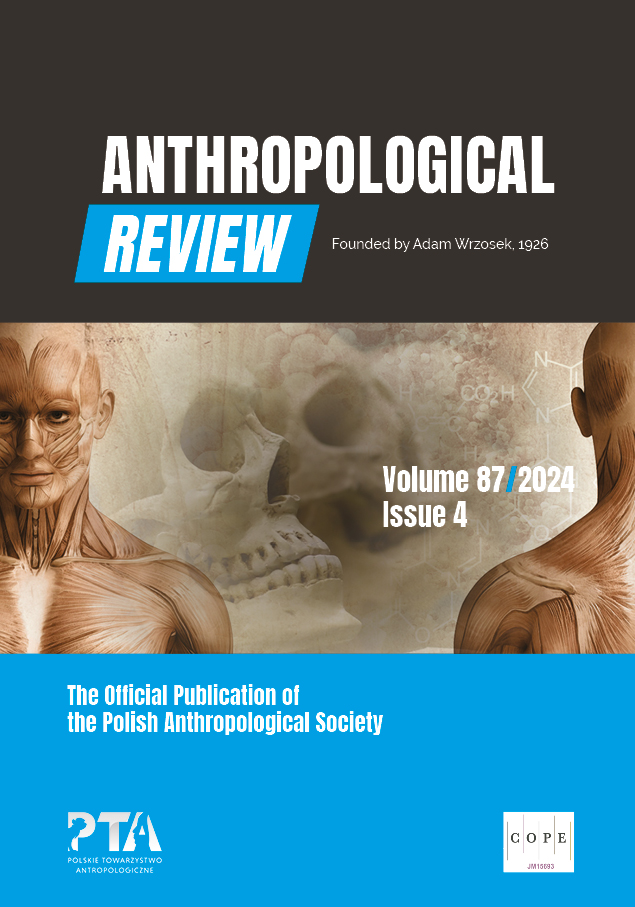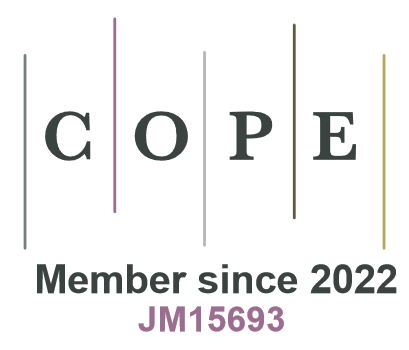How do age and sex influence pain threshold and tolerance among Santal tribal people living in West Bengal, India?
DOI:
https://doi.org/10.18778/1898-6773.87.4.05Keywords:
pain threshold, pain tolerance, age, sex, interaction effectAbstract
The perception of pain, encompassing pain threshold and tolerance levels, is a complex phenomenon influenced by biological, psychological, and sociocultural factors. Notably, age and sex have consistently emerged as pivotal determinants in modulating pain perception. The study aimed to examine age and sex differences in pain threshold and tolerance levels. Furthermore, it delved into exploring whether age-related differences in pain threshold and tolerance levels vary between males and females. This study incorporated 484 healthy Santal tribal individuals aged 18–88 years (male 203 and female 281) living in Howrah and Purba Bardhaman Districts of West Bengal State, India, who reported no chronic or significant pain at the time of data collection. Pain threshold and tolerance levels were assessed using a digital algometer. Results of two-way ANOVA revealed significant main effects of age and sex on every pain threshold and tolerance level assessed in this study, indicating that older individuals had lower pain threshold and tolerance levels than younger ones. Males demonstrated greater levels of pain threshold and tolerance relative to females. Age and sex showed a significant interaction effect on pain tolerance levels, but not on pain threshold levels demonstrating the age-associated declining trend in pain threshold levels was consistent for either sex; however, such a tendency in pain tolerance levels was more pronounced in men. These findings highlight the importance of considering age and sex factors when assessing pain perception.
Downloads
References
Anderson SR, Losin EAR. 2017. A sociocultural neuroscience approach to pain. Culture and Brain 5:14–35. https://doi.org/10.1007/s40167-016-0037-4
View in Google Scholar
DOI: https://doi.org/10.1007/s40167-016-0037-4
Archey M, Goldey K, Crockett E, Boyette-Davis J. 2019. An Investigation of the Effects of Testosterone and Behavioral Expressions of Pain on Sex/Gender Differences in Pain Perception. Psychol Rep 122:826–840. https://doi.org/10.1177/0033294118781320
View in Google Scholar
DOI: https://doi.org/10.1177/0033294118781320
Bartley EJ, Fillingim RB. 2013. Sex differences in pain: a brief review of clinical and experimental findings. Br J Anaesth 111:52–58. https://doi.org/10.1093/bja/aet127
View in Google Scholar
DOI: https://doi.org/10.1093/bja/aet127
Bartley EJ, Palit S, Kuhn BL, Kerr KL, Terry EL, DelVentura JL, et al. 2015. Natural variation in testosterone is associated with hypoalgesia in healthy women. Clin J Pain 31:730–739. https://doi.org/10.1097/AJP.0000000000000153
View in Google Scholar
DOI: https://doi.org/10.1097/AJP.0000000000000153
Bek N, Uygur F, Bayar B, Armutlu K. 2002. Analysis of age and gender related differences in pressure pain threshold and pressure pain tolerance levels. Pain Clinic 14:309–314. https://doi.org/10.1163/15685690260494843
View in Google Scholar
DOI: https://doi.org/10.1163/15685690260494843
Belfer I. 2013. Nature and nurture of human pain. Scientifica 2013:415279. https://doi.org/10.1155/2013/415279
View in Google Scholar
DOI: https://doi.org/10.1155/2013/415279
Bodnar RJ, Romero MT, Kramer E. 1988. Organismic variables and pain inhibition: roles of gender and aging. Brain Res Bull 21:947–953. https://doi.org/10.1016/0361-9230(88)90032-9
View in Google Scholar
DOI: https://doi.org/10.1016/0361-9230(88)90032-9
Boro B, Saikia N. 2020. A qualitative study of the barriers to utilizing healthcare services among the tribal population in Assam. PLoS One 15:e0240096. https://doi.org/10.1371/journal.pone.0240096
View in Google Scholar
DOI: https://doi.org/10.1371/journal.pone.0240096
Bulls HW, Freeman EL, Anderson AJ, Robbins MT, Ness TJ, Goodin BR. 2015. Sex differences in experimental measures of pain sensitivity and endogenous pain inhibition. J Pain Res 8:311–320. https://doi.org/10.2147/JPR.S84607
View in Google Scholar
DOI: https://doi.org/10.2147/JPR.S84607
Burger HG, Hale GE, Robertson DM, Dennerstein L. 2007. A review of hormonal changes during the menopausal transition: focus on findings from the Melbourne Women’s Midlife Health Project. Hum Reprod Update 13:559–565. https://doi.org/10.1093/humupd/dmm020
View in Google Scholar
DOI: https://doi.org/10.1093/humupd/dmm020
Cámara RJA, Gharbo RK, Egloff N. 2020. Age and Gender as Factors of Pressure Sensitivity of Pain-Free Persons: Are They Meaningful? J Pain Res 13:1849–1859. https://doi.org/10.2147/JPR.S248664
View in Google Scholar
DOI: https://doi.org/10.2147/JPR.S248664
Cimpean A, David D. 2019. The mechanisms of pain tolerance and pain-related anxiety in acute pain. Health Psychol Open 6:2055102919865161. https://doi.org/10.1177/2055102919865161
View in Google Scholar
DOI: https://doi.org/10.1177/2055102919865161
Cohen J. 1988. Statistical Power Analysis for the Behavioral Sciences. New York: Routledge Academic.
View in Google Scholar
Cole LJ, Farrell MJ, Gibson SJ, Egan GF. 2010. Age-related differences in pain sensitivity and regional brain activity evoked by noxious pressure. Neurobiol Aging 31:494–503. https://doi.org/10.1016/j.neurobiolaging.2008.04.012
View in Google Scholar
DOI: https://doi.org/10.1016/j.neurobiolaging.2008.04.012
Defrin R, Shramm L, Eli I. 2009. Gender role expectations of pain is associated with pain tolerance limit but not with pain threshold. Pain 145:230–236. https://doi.org/10.1016/j.pain.2009.06.028
View in Google Scholar
DOI: https://doi.org/10.1016/j.pain.2009.06.028
DiMatteo MR, Martin LR. 2002. Health Psychology. Boston: Allyn and Bacon.
View in Google Scholar
Domenichiello AF, Ramsden CE. 2019. The silent epidemic of chronic pain in older adults. Prog Neuropsychopharmacol Biol Psychiatry 93:284–290. https://doi.org/10.1016/j.pnpbp.2019.04.006
View in Google Scholar
DOI: https://doi.org/10.1016/j.pnpbp.2019.04.006
Duan G, Xiang G, Zhang X, Guo S, Zhang Y. 2014. An improvement of mechanical pain sensitivity measurement method: the smaller sized probes may detect heterogeneous sensory threshold in healthy male subjects. Pain Med 15:272–280. https://doi.org/10.1111/pme.12245
View in Google Scholar
DOI: https://doi.org/10.1111/pme.12245
Edwards RR, Fillingim RB. 2001. Age-associated differences in responses to noxious stimuli. J Gerontol 56:M180–185. https://doi.org/10.1093/gerona/56.3.m180
View in Google Scholar
DOI: https://doi.org/10.1093/gerona/56.3.M180
Edwards RR, Fillingim RB, Ness TJ. 2003. Age-related differences in endogenous pain modulation: a comparison of diffuse noxious inhibitory controls in healthy older and younger adults. Pain 101:155–165. https://doi.org/10.1016/s0304-3959(02)00324-x
View in Google Scholar
DOI: https://doi.org/10.1016/S0304-3959(02)00324-X
El Tumi HG, Tashani OA. 2017. Effect of age, sex and gender on pain sensitivity: a narrative review. The Open Pain J 10:44–55. https://doi.org/10.2174/1876386301710010044
View in Google Scholar
DOI: https://doi.org/10.2174/1876386301710010044
Elgaddal N, Kramarow EA, Weeks JD, Reuben C. 2024. Arthritis in Adults Age 18 and Older: United States, 2022. US Department of Health and Human Services, Centers for Disease Control and Prevention, National Center for Health Statistics. https://stacks.cdc.gov/view/cdc/145594
View in Google Scholar
DOI: https://doi.org/10.15620/cdc:145594
Failla MD, Beach PA, Atalla S, Dietrich MS, Bruehl S, Cowan RL, et al. 2024. Gender Differences in Pain Threshold, Unpleasantness, and Descending Pain Modulatory Activation Across the Adult Life Span: A Cross Sectional Study. J Pain 25:1059–1069. https://doi.org/10.1016/j.jpain.2023.10.027
View in Google Scholar
DOI: https://doi.org/10.1016/j.jpain.2023.10.027
Ferreira SA, Kokubun E, Gobbi S, Fernandes RA, Queiróga MR. 2015. Musculoskeletal pain perception and hypertension. Revista Dor 16:43–47. https://doi.org/10.5935/1806-0013.20150009
View in Google Scholar
DOI: https://doi.org/10.5935/1806-0013.20150009
Fillingim RB, Maixner W, Girdler SS, Light KC, Harris MB, Sheps DS, et al. 1997. Ischemic but not thermal pain sensitivity varies across the menstrual cycle. Psychosom Med 59:512–520. https://doi.org/10.1097/00006842-199709000-00008
View in Google Scholar
DOI: https://doi.org/10.1097/00006842-199709000-00008
Gazerani P, Aloisi AM, Ueda H. 2021. Editorial: Differences in Pain Biology, Perception, and Coping Strategies: Towards Sex and Gender Specific Treatments. Front Neurosci 15:697285. https://doi.org/10.3389/fnins.2021.697285
View in Google Scholar
DOI: https://doi.org/10.3389/fnins.2021.697285
Georgoudis G, Oldham J, Watson PJ, Grammatopoulou E. 2014. Reliability measures of subcutaneous pressure pain threshold measurements: a proposed method of assessing painful musculoskeletal disorders. J Nov Physiother 4:1–8.
View in Google Scholar
DOI: https://doi.org/10.4172/2165-7025.1000234
Gibson SJ. 2003. Pain and aging: The pain experience over the adult life span. In: JO Dostrovsky, DB Carr, M Koltzenburg, editors. Proceedings of the 10th world congress on pain, progress in pain research and management. Volume 24. Seattle: IASP Press. 767–790.
View in Google Scholar
Gibson SJ, Farrell M. 2004. A review of age differences in the neurophysiology of nociception and the perceptual experience of pain. Clin J Pain 20:227–239. https://doi.org/10.1097/00002508-200407000-00004
View in Google Scholar
DOI: https://doi.org/10.1097/00002508-200407000-00004
González-Roldán AM, Terrasa JL, Sitges C, van der Meulen M, Anton F, Montoya P. 2020. Age-Related Changes in Pain Perception Are Associated With Altered Functional Connectivity During Resting State. Front Aging Neurosci 12:116. https://doi.org/10.3389/fnagi.2020.00116
View in Google Scholar
DOI: https://doi.org/10.3389/fnagi.2020.00116
Hackett J, Naugle KE, Naugle KM. 2020. The Decline of Endogenous Pain Modulation With Aging: A Meta-Analysis of Temporal Summation and Conditioned Pain Modulation. J Pain 21:514–528. https://doi.org/10.1016/j.jpain.2019.09.005
View in Google Scholar
DOI: https://doi.org/10.1016/j.jpain.2019.09.005
Helme RD, Meliala A, Gibson SJ. 2004. Methodologic factors which contribute to variations in experimental pain threshold reported for older people. Neurosci Lett 361:144–146. https://doi.org/10.1016/j.neulet.2003.12.014
View in Google Scholar
DOI: https://doi.org/10.1016/j.neulet.2003.12.014
International Institute of Population Science (IIPS) and ICF. 2017. National Family Health Survey (NFHS-4) 2015–16, India (Mumbai: IIPS).
View in Google Scholar
Koutantji M, Pearce SA, Oakley DA. 1998. The relationship between gender and family history of pain with current pain experience and awareness of pain in others. Pain 77:25–31. https://doi.org/10.1016/S0304-3959(98)00075-X
View in Google Scholar
DOI: https://doi.org/10.1016/S0304-3959(98)00075-X
Lautenbacher S, Kunz M, Strate P, Nielsen J, Arendt-Nielsen L. 2005. Age effects on pain thresholds, temporal summation and spatial summation of heat and pressure pain. Pain 115:410–418. https://doi.org/10.1016/j.pain.2005.03.025
View in Google Scholar
DOI: https://doi.org/10.1016/j.pain.2005.03.025
Lautenbacher S, Peters JH, Heesen M, Scheel J, Kunz M. 2017. Age changes in pain perception: A systematic-review and meta-analysis of age effects on pain and tolerance thresholds. Neurosci Biobehav Rev 75:104–113. https://doi.org/10.1016/j.neubiorev.2017.01.039
View in Google Scholar
DOI: https://doi.org/10.1016/j.neubiorev.2017.01.039
Lorusso L, Salerno M, Sessa F, Nicolosi D, Longhitano L, Loreto C, et al. 2018. Autoalgometry: An Important Tool for Pressure Pain Threshold Evaluation. J Clin Med 7:273. https://doi.org/10.3390/jcm7090273
View in Google Scholar
DOI: https://doi.org/10.3390/jcm7090273
Lue YJ, Wang HH, Cheng KI, Chen CH, Lu YM. 2018. Thermal pain tolerance and pain rating in normal subjects: Gender and age effects. Eur J Pain 22:1035–1042. https://doi.org/10.1002/ejp.1188
View in Google Scholar
DOI: https://doi.org/10.1002/ejp.1188
McEntarfer C, DiPirro J, Page D. 2005. The Effects of Gender and Aging on Pain Perception. Psi Chi J Psychol Res 10:145–149.
View in Google Scholar
DOI: https://doi.org/10.24839/1089-4136.JN10.4.145
Meriggiola MC, Nanni M, Bachiocco V, Vodo S, Aloisi AM. 2012. Menopause affects pain depending on pain type and characteristics. Menopause 19:517–523. https://doi.org/10.1097/gme.0b013e318240fe3d
View in Google Scholar
DOI: https://doi.org/10.1097/gme.0b013e318240fe3d
Moore AR, Clinch D. 2004. Underlying mechanisms of impaired visceral pain perception in older people. J Am Geriatr Soc 52:132–136. https://doi.org/10.1111/j.1532-5415.2004.52023.x
View in Google Scholar
DOI: https://doi.org/10.1111/j.1532-5415.2004.52023.x
Nikolov V, Petkova M. 2010. Pain sensitivity among women with low estrogen levels. Procedia Soc Behav Sci 5:289–293. https://doi.org/10.1016/j.sbspro.2010.07.090
View in Google Scholar
DOI: https://doi.org/10.1016/j.sbspro.2010.07.090
Overstreet DS, Strath LJ, Jordan M, Jordan IA, Hobson JM, Owens MA, et al. 2023. A Brief Overview: Sex Differences in Prevalent Chronic Musculoskeletal Conditions. Int J Environ Res Public Health 20:4521. https://doi.org/10.3390/ijerph20054521
View in Google Scholar
DOI: https://doi.org/10.3390/ijerph20054521
Pelfort X, Torres-Claramunt R, Sánchez-Soler JF, Hinarejos P, Leal-Blanquet J, Valverde D, et al. 2015. Pressure algometry is a useful tool to quantify pain in the medial part of the knee: an intra- and inter-reliability study in healthy subjects. Orthop Traumatol Surg Res 101:559–563. https://doi.org/10.1016/j.otsr.2015.03.016
View in Google Scholar
DOI: https://doi.org/10.1016/j.otsr.2015.03.016
Petrini L, Matthiesen ST, Arendt-Nielsen L. 2015. The effect of age and gender on pressure pain thresholds and suprathreshold stimuli. Perception 44:587–596. https://doi.org/10.1068/p7847
View in Google Scholar
DOI: https://doi.org/10.1068/p7847
Pickering G, Jourdan D, Eschalier A, Dubray C. 2002. Impact of age, gender and cognitive functioning on pain perception. Gerontology 48:112–118. https://doi.org/10.1159/000048937
View in Google Scholar
DOI: https://doi.org/10.1159/000048937
Racine M, Tousignant-Laflamme Y, Kloda LA, Dion D, Dupuis G, Choinière M. 2012. A systematic literature review of 10 years of research on sex/gender and experimental pain perception - part 1: are there really differences between women and men? Pain 153:602–618. https://doi.org/10.1016/j.pain.2011.11.025
View in Google Scholar
DOI: https://doi.org/10.1016/j.pain.2011.11.025
Roy SK, Kar Chakraborty S, Mozumdar A. 2013. Health: Cognition and threshold among the Oraon tea garden labourers of Jalpaiguri District, West Bengal. J Anthropol 2013:987584. https://doi.org/10.1155/2013/987584
View in Google Scholar
DOI: https://doi.org/10.1155/2013/987584
Rutstein SO. 2008. DHS working papers. The DHS Wealth Index: Approaches for Rural and Urban Areas. Macro International, USA.
View in Google Scholar
Santra A, Roy SK, Goswami M, Chatterjee D. 2024. An exploratory study on sex differences in musculoskeletal pain and its associated factors among the Santal indigenous people of West Bengal, India. Discov Soc Sci Health 4:67. https://doi.org/10.1007/s44155-024-00123-y
View in Google Scholar
DOI: https://doi.org/10.1007/s44155-024-00123-y
Schmitz AK, Vierhaus M, Lohaus A. 2013. Pain tolerance in children and adolescents: sex differences and psychosocial influences on pain threshold and endurance. Eur J Pain 17:124–131. https://doi.org/10.1002/j.1532-2149.2012.00169.x
View in Google Scholar
DOI: https://doi.org/10.1002/j.1532-2149.2012.00169.x
Shipton EA. 2013. The pain experience and sociocultural factors. N Z Med J 126:7–9.
View in Google Scholar
Singh V, Singh M. 2017. Dynamic Concept of Tribes in India: A Historical Excursion. International Journal of Economic Perspectives 11:160–168.
View in Google Scholar
Stevens B. 2021. Revisions to the IASP definition of pain-What does this mean for children? Paediatr Neonatal Pain 3:101–105. https://doi.org/10.1002/pne2.12047
View in Google Scholar
DOI: https://doi.org/10.1002/pne2.12047
Swift A. 2018. Understanding pain and the human body’s response to it. Nurs Times 114:22–26.
View in Google Scholar
Vincent K, Tracey I. 2008. Hormones and their Interaction with the Pain Experience. Rev Pain 2:20–24. https://doi.org/10.1177/204946370800200206
View in Google Scholar
DOI: https://doi.org/10.1177/204946370800200206
Walton DM, Macdermid JC, Nielson W, Teasell RW, Nailer T, Maheu P. 2011. A descriptive study of pressure pain threshold at 2 standardized sites in people with acute or subacute neck pain. J Orthop Sports Phys Ther 41:651–657. https://doi.org/10.2519/jospt.2011.3667
View in Google Scholar
DOI: https://doi.org/10.2519/jospt.2011.3667
Woodrow KM, Friedman GD, Siegelaub AB, Collen MF. 1972. Pain tolerance: differences according to age, sex and race. Psychosom Med 34:548–556. https://doi.org/10.1097/00006842-197211000-00007
View in Google Scholar
DOI: https://doi.org/10.1097/00006842-197211000-00007
Yağci N, Duymaz T, Cavlak U. 2014. How does pain localization affect physical functioning, emotional status and independency in older adults with chronic musculoskeletal pain? J Phys Ther Sci 26:1189–1192. https://doi.org/10.1589/jpts.26.1189
View in Google Scholar
DOI: https://doi.org/10.1589/jpts.26.1189
Yezierski RP. 2012. The effects of age on pain sensitivity: preclinical studies. Pain Med 13 Suppl 2:S27-36. https://doi.org/10.1111/j.1526-4637.2011.01311.x
View in Google Scholar
DOI: https://doi.org/10.1111/j.1526-4637.2011.01311.x
Published
Versions
- 31-01-2025 (2)
- 31-01-2025 (1)
How to Cite
Issue
Section
License

This work is licensed under a Creative Commons Attribution-NonCommercial-NoDerivatives 4.0 International License.
Funding data
-
University Grants Commission
Grant numbers 809/(NET-NOV2017)









